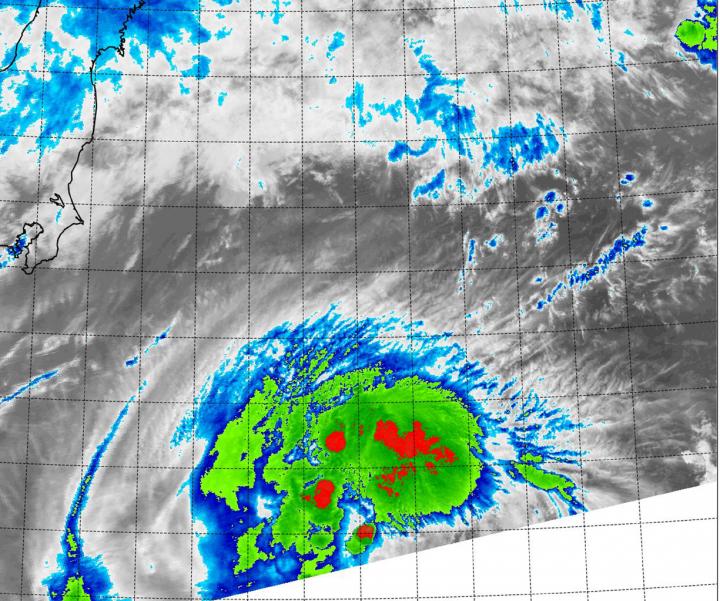NASA's Terra satellite sees Molave regain tropical storm status

On Aug. 11 at 8:05 a.m. EDT the MODIS instrument aboard NASA's Terra satellite captured this infrared image fragmented strong storms (red) in Tropical Storm Molave's northern quadrant. Credits: NASA Goddard MODIS Rapid Response Team
On Aug. 4 at 4:00 UTC (12:00 a.m. EDT) the Moderate Resolution Imaging Spectroradiometer or MODIS instrument aboard NASA's Terra satellite captured an infrared image of a stronger Tropical Storm Molave.
The infrared imagery revealed fragmented, but very cold thunderstorm cloud tops northwest, north and northeast of the center of circulation.
Those cold cloud tops were indicative of stronger convection (rising air that forms thunderstorms).
At 1500 UTC (11 a.m. EDT) on August 11, Molave's maximum sustained winds increased to near 45 knots (51.7 mph/83.3 kph).
It was centered near 32.5 North latitude and 144.5 East longitude, about 292 nautical miles (336 miles/540.8 km) southeast of Yokosuka, Japan.
Molave was moving to the west-northwest at 8 knots (9.2 mph/14.8 kph).
As Molave moves to the northeast, the storm is intensifying.
The Joint Typhoon Warning Center expects Molave to peak at 60 knots (69 mph/111 kph) before becoming extra-tropical southeast of Kamchatka.
Media Contact
All latest news from the category: Earth Sciences
Earth Sciences (also referred to as Geosciences), which deals with basic issues surrounding our planet, plays a vital role in the area of energy and raw materials supply.
Earth Sciences comprises subjects such as geology, geography, geological informatics, paleontology, mineralogy, petrography, crystallography, geophysics, geodesy, glaciology, cartography, photogrammetry, meteorology and seismology, early-warning systems, earthquake research and polar research.
Newest articles

NASA: Mystery of life’s handedness deepens
The mystery of why life uses molecules with specific orientations has deepened with a NASA-funded discovery that RNA — a key molecule thought to have potentially held the instructions for…

What are the effects of historic lithium mining on water quality?
Study reveals low levels of common contaminants but high levels of other elements in waters associated with an abandoned lithium mine. Lithium ore and mining waste from a historic lithium…

Quantum-inspired design boosts efficiency of heat-to-electricity conversion
Rice engineers take unconventional route to improving thermophotovoltaic systems. Researchers at Rice University have found a new way to improve a key element of thermophotovoltaic (TPV) systems, which convert heat…



